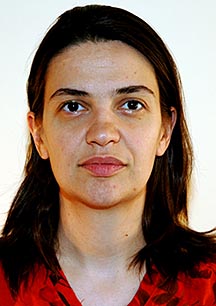A Winning Combination of Expertise
Interview with IdeaConnection Problem Solver Irina Catrina By Paul Arnold
Irina Catrina is a bioorganic chemist at Hunter College, New York where her research activities are currently focused on the study of live Drosophila melanogaster oocytes. Here she talks about her work, and the success she achieved with her first IdeaConnection challenge. Overall, it was a great experience working on the team. I do like to work with other people, and the one challenge that I’ve worked on so far, required a lot of theoretical work that needed expertise in many fields so I don’t think one person could’ve solved it successfully. The challenge needed various backgrounds.
Overall, it was a great experience working on the team. I do like to work with other people, and the one challenge that I’ve worked on so far, required a lot of theoretical work that needed expertise in many fields so I don’t think one person could’ve solved it successfully. The challenge needed various backgrounds.I have worked as an individual solver elsewhere, but the experience was not as I hoped it would be. So when IdeaConnection contacted me and asked if I would want to work with a group I was happy. It’s a good idea because I can get feedback from other people and then I know I am going in the right direction.
Rocket Fuel for the Brain
I also learned a lot by being part of the team. I’m an RNA person so I learned more about tools for DNA transcription factors and identifying sites among other things. In addition, I have never worked with plants. So moving to a plant setting and having at least two other people in the group that were experts in plants was beneficial. I can also say that the experience is definitely helping me in my professional life. In the group you hear many different points of view which gives you more ideas and helps you to think of things from different perspectives.
It was a very nice group to be a part of and everybody was so helpful. If you were stuck and didn’t know where to go everybody had a good suggestion – ‘maybe we should do this or try that’. We were all working on different parts of the challenge and the work was distributed according to our expertise.
Contingency Working
In the group we did talk about contingency and someone suggested that if our solution wasn’t accepted we could get a paper out of it. If the seeker doesn’t accept your solution the effort you put in hasn’t gone to waste because at the very least the reading and learning will help you in your work. We were successful in that we received a partial award, which was very nice, at least to be partly successful.
Current Research Field
In my work we’re looking at imaging a live transport of RNA and we use the drosophila egg chamber for that. We can see endogenous messenger RNA as it travels into the egg chamber which is a multi-cellular system, so you see it move from the site of transcription to where messenger RNA will be localized. We are working on visualising RNA with proteins at the same time, and trying to figure out translational control.
Translational control is a complex problem. You have messenger RNA that has to be translated at a certain time otherwise the egg will not develop normally. So the fly develops all these mechanisms that make sure that this RNA is not translated prematurely from the time it’s made to the time it’s localized where it’s supposed to be translated. Our studies of this involve people in the group looking at different aspects of translational control. It’s to understand more about how translational repression and activation takes place.
Why I’m a Scientist
I started in chemical engineering. I just like chemistry, and then I decided to do a PhD and moved to organic chemistry and enjoyed my PhD work at Utah State. Having such a wonderful time there is what told me that I have to be a scientist. I like the bench work a lot. I do plenty of computational work but the bench work keeps me going.
